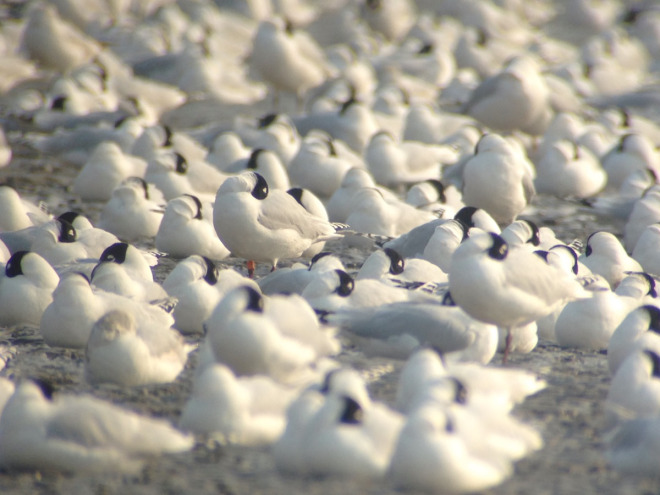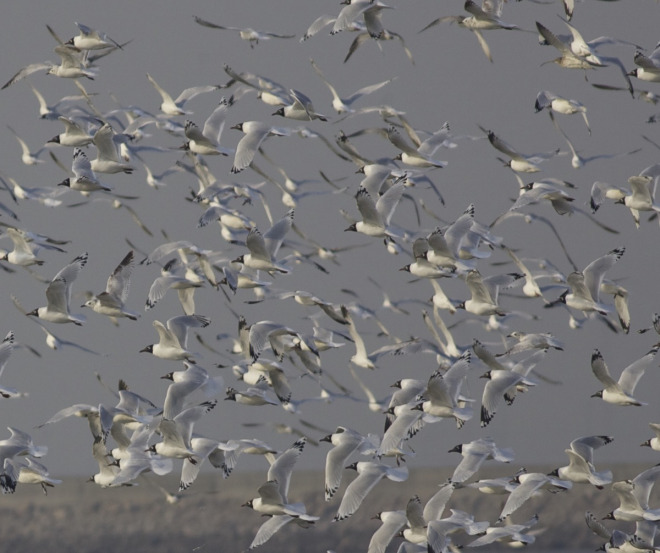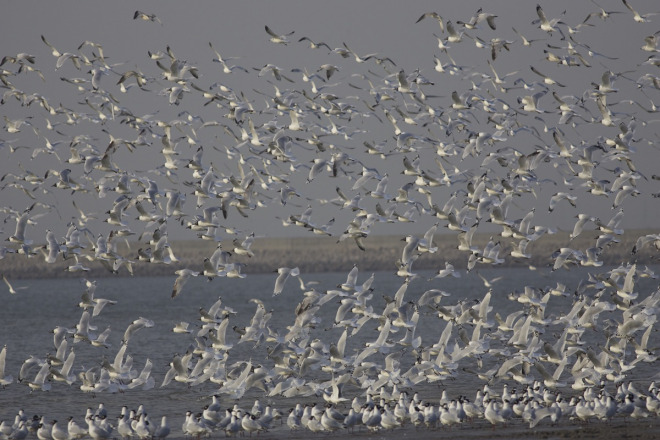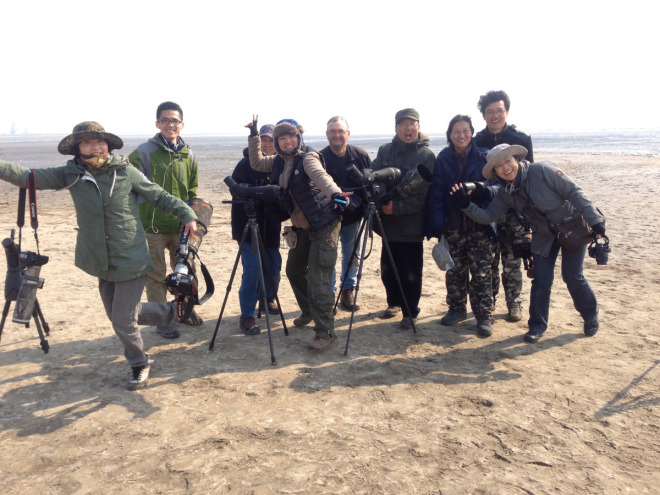It was as recently as 1970 that RELICT GULL (Larus relictus, ??) was confirmed as a valid species. Before that it was thought to be either an eastern race of Mediterranean Gull (Ichthyaetus melanocephalus) or a hybrid between Brown-headed Gull (Chroicocephalus brunnicephalus) and Pallas’s Gull (Ichthyaetus ichthyaetus)! Since its rather late acceptance into the global ornithological fold much has been discovered about this beautiful gull. Breeding sites have been found in China, Russia, Kazakhstan and Mongolia and it appears that, although a few spend the winter in Korea, almost the entire world population winters on the northeast China coast, around the Bohai Bay. And just before their spring migration, gatherings on the coast of birds in stunning breeding plumage, are simply spectacular. Last week, local Tianjin birder Mo Xunqian (“Nemo”) and friend Zhu Bingrun (“Drew”) counted 10,652 Relict Gulls from 3 sites around Hangu, Tianjin. This is a world record count and was simply too much to resist. So, together with Paul Holt and members of Beijing Birdwatching Society, including President Fu Jianping, I headed to the coast to try to catch a glimpse of these awesome birds before they left for the breeding grounds. With the help of Nemo and local bird photographer and conservationist Mr Wang Jianmin, we arrived on site at the perfect time – just as the tide was beginning to fall. And we were greeted with a sea of Relict Gulls, the adults resplendent in their hooded breeding plumage and with hormones raging. Many were engaging in courtship display, throwing back their heads and holding open their wings as they called loudly. Superb!
After a few minutes of simply admiring this breathtaking spectacle, Paul was quick to get to work counting the flock. His tally was an outstanding 10,405, a record for a single site. I focused on capturing some video footage and, as the wind began to increase, making the conditions difficult for video, I began to scan the flock, observing their behaviour and enjoying the birds.
It wasn’t long before I found a leg-flagged adult sporting an orange flag on its right tibia and then, incredibly, another with an orange flag engraved with the number “1”.
We enjoyed several hours with these birds until, as the tide receded, the birds began to move out onto the mud to feed. Every few minutes, as more mud became exposed, the whole flock would rise into the air, wheeling around before settling a few metres closer to the retreating sea. It was an awesome sight. All against the unlikely backdrop of an aircraft carrier, moored to the north…
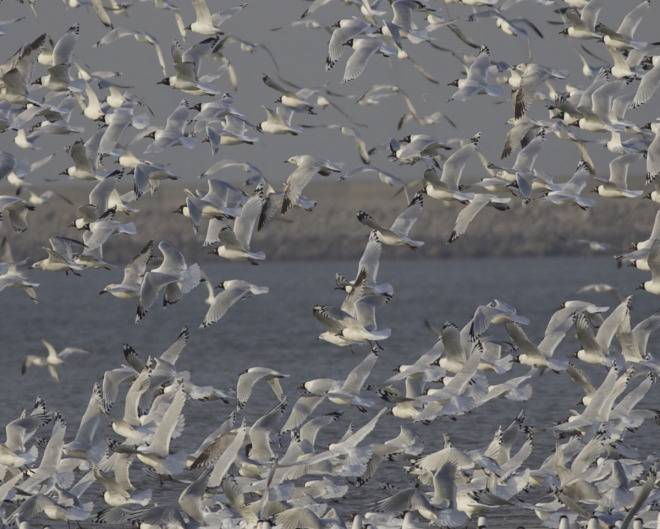
Relict-Gulls-Hangu-Tianjin-26-March-2015.-Occasionally-the-flock-would-take-to-the-air-following-the-retreating-sea.
As the birds moved away we made our way back to the car, still buzzing from witnessing one of the most impressive birding sights during my time in China.
Mr Wang took us to a local restaurant for lunch where we reflected on the status of Relict Gull. It was then that a hint of sadness hit us. As impressive as this spectacle was, the fact that so many are concentrated in one spot is not a good sign. It’s a symptom of shrinking habitat. And the concentration into such a small area makes the population extremely vulnerable to shocks.. A serious oil spill, for example, could devastate these birds.
Anyone familiar with east Asia won’t be surprised that the cause of the shrinking habitat is land reclamation. Mr Wang told us that, so far, around 80% of Tianjin’s tidal mudflats have been reclaimed, with just over 30km of coastal mudflat remaining of an original 140+km. And then the news got worse; the site where we had just recorded a world record count of this special gull was due to be reclaimed and turned into housing. My heart sank.
Much has been made of the breathtaking pace of ‘development’ along China’s east coast, in particular in the context of Spoon-billed Sandpiper. And whilst the disappearance of tidal mudflats will undoubtedly affect many shorebird species, the Relict Gull is perhaps the most vulnerable species of all. With almost the entire global population dependent on the tidal mudflats of the Bohai Bay, this bird is being squeezed into ever-decreasing pockets of viable habitat. At the present rate of land reclamation it is questionable for how long the remaining areas of tidal mudflats will be able to sustain the wintering population. And with human disturbance, unsustainable water use and climate change, there are significant threats to the breeding grounds, too. The Relict Gull fully deserves its “Vulnerable” status.
Development is clearly necessary for the government to continue to bring millions of Chinese out of poverty. That includes expanding ports, improving infrastructure and building homes and businesses. The key question is whether or not this development can be more sensitive to the natural world. Unfortunately, it is still the case that ecosystems and biodiversity have zero value in our economic model. That’s not unique to China, it’s a global phenomenon. To protect sites and species often requires monumental efforts from passionate individuals and groups. It should be the default.
Mr Wang has been championing the need to protect the remaining tidal mudflats around Tianjin. He has exhibited his excellent photographs to raise awareness among the local community and, importantly, he has met with local government officials to highlight the global importance of this habitat. He is committed to doing everything he can to help Relict Gull, a species that is clearly very close to his heart. With the vast majority of the population breeding in China and wintering along the Bohai Bay, Relict Gull is a Chinese treasure, just like the Forbidden City, Temple of Heaven or the Terracotta Warriors. I hope that, one day, it will be given the same protection.
Big thanks to Nemo, Zhu Bingrun, Wang Jianmin, Paul Holt, Wang Qingyu, Fu Jianping and the Beijing Birdwatching Society for ensuring our trip to see Relict Gulls was successful, for the use of photographs and for their fun company in Tianjin.
Original article: http://birdingbeijing.com/2015/03/28/10000-relict-gulls/


